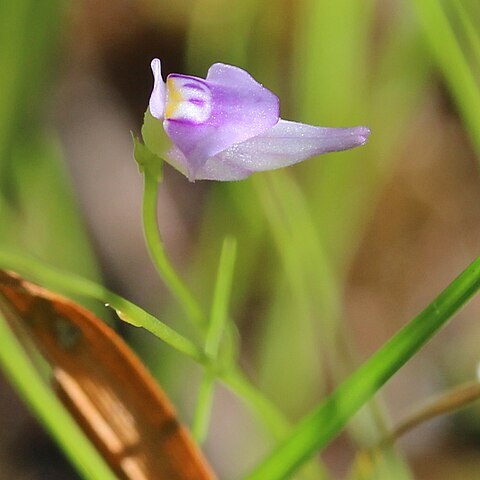Terrestrial. Rhizoids few to very numerous, capillary, simple. Stolons capillary, sparsely branched. Foliar organs not always conspicuous at anthesis, rosulate and on the stolons, narrowly obovate-spathulate, up to 7 mm long and 1.5 mm wide, apex rounded, 1-nerved. Traps rather few on the vegetative organs, ± dimorphic, ovoid, shortly stalked, mouth terminal, oblique, the larger traps up to 1.5 mm long including a long carinate beak on the upper lip, the smaller traps about half as long with a relatively shorter beak, mouth and beak of both types densely stipitate-glandular. Inflorescence erect, 5-30 cm long; peduncle filiform to relatively stout, 0.3-1.5 mm thick, terete, glabrous; flowers 1-20 or more very variably disposed, distant to quite densely congested and sub-capitate; scales numerous, similar to the bracts; bracts medifixed, variably attached above or below the middle, narrowly rhombic, acuminate at both extremities, 2-2.5 mm long; bracteoles similar but often shorter and narrower; pedicels erect at anthesis, spreading or reflexed in fruit, filiform, terete, 0.5-1 mm long. Calyx lobes unequal, usually minutely papillose, upper ovate-oblong, cucullate, 2-3 mm long, apex rounded, lower shorter, transversely elliptic with conspicuously inrolled margins. Corolla pink, mauve, purple or blue, often white and sometimes ? yellow, 4-10 mm long, externally minutely papillose, upper lip narrowly ovate-oblong, longer than upper calyx lobe, apex rounded or truncate, lower lip larger, ± orbicular, apex retuse, palate raised, ± conspicuously transversely crested, spur narrowly conical or cylindrical from a broader conical base, straight or curved, usually longer than and ± parallel with the lower lip. Filaments filiform, straight, c. 1 mm long, anther thecae distinct, minutely papillose. Ovary ovoid, style variably in length, usually distinct, stigma lower lip orbicular, upper lip minute, deltoid. Capsule globose, c. 2 mm long, firm, opaque, dehiscing by a ventral longitudinal slit. Seeds numerous, obliquely oblong-ellipsoid, c. 0.3 mm long, testa thin, smooth to distinctly papillose, obscurely reticulate, reticulations elongate.
More
Annuals, terrestrial. Rhizoids and stolons capillary, branched. Traps on stolons and leaves, stalked, ovoid, 0.2-1 mm, with stipitate glands on appendage and mouth margin, mouth lateral; appendage 1, dorsal, subulate, beaklike. Leaves numerous, from peduncle base and stolon nodes, glabrous; leaf blade linear to linear-obovate, 0.3-2 cm × 0.5-2 mm, membranous, veins 3, base attenuate onto petiole, margin entire, apex rounded. Inflorescences erect, 5-44 cm, 1-15-flowered, glabrous; peduncle terete, 0.3-1.2 mm thick; scales 1-12, similar to bracts; bracts basisolute, oblanceolate, 1.5-3 mm, base cuneate, apex acute. Pedicel erect at anthesis but spreading to deflexed in fruit, 0.2-1 mm, minutely papillose; bracteoles basisolute, ovate-lanceolate, 1-2 mm. Calyx lobes minutely papillose, glabrous; lower lobe suborbicular, smaller than upper lobe, apex retuse; upper lobe ovate-oblong, 2-3 mm, apex rounded. Corolla violet, pink, or white, marked with yellow at throat, 4-10 mm; lower lip broadly ovate, with a basal 4-ridged swelling, apex rounded to emarginate; spur narrowly conic, usually longer than lower corolla lip, apex subacute; upper lip oblong to ovate-oblong, apex retuse. Filaments 1-2 mm, straight; anther thecae ± distinct. Ovary globose; style short; stigma lower lip semicircular, upper lip deltoid. Capsule globose to ellipsoid, 1.5-2 mm, dehiscing by a short longitudinal ventral slit. Seeds obovoid to oblong-ellipsoid, 0.2-0.3 mm; seed coat with prominent elongate reticulations and conic to clavate papillae. Fl. Jun-Jan, fr. Jul-Feb. 2n = 36, 40.

